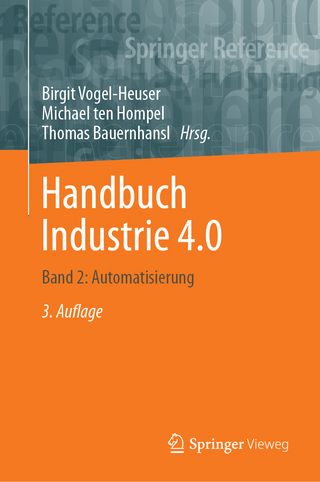
Structural Dynamic Analysis with Generalized Damping Models
ISTE Ltd and John Wiley & Sons Inc (Verlag)
978-1-84821-670-9 (ISBN)
- Titel z.Zt. nicht lieferbar
- Versandkostenfrei innerhalb Deutschlands
- Auch auf Rechnung
- Verfügbarkeit in der Filiale vor Ort prüfen
- Artikel merken
Over the past decade, extensive research has been undertaken on more general “non-viscous” damping models and vibration of non-viscously damped systems. This book, along with a related book Structural Dynamic Analysis with Generalized Damping Models: Analysis, is the first comprehensive study to cover vibration problems with general non-viscous damping. The author draws on his considerable research experience to produce a text covering: parametric senistivity of damped systems; identification of viscous damping; identification of non-viscous damping; and some tools for the quanitification of damping. The book is written from a vibration theory standpoint, with numerous worked examples which are relevant across a wide range of mechanical, aerospace and structural engineering applications.
Contents
1. Parametric Sensitivity of Damped Systems.
2. Identification of Viscous Damping.
3. Identification of Non-viscous Damping.
4. Quantification of Damping.
About the Authors
Sondipon Adhikari is Chair Professor of Aerospace Engineering at Swansea University, Wales. His wide-ranging and multi-disciplinary research interests include uncertainty quantification in computational mechanics, bio- and nanomechanics, dynamics of complex systems, inverse problems for linear and nonlinear dynamics, and renewable energy. He is a technical reviewer of 97 international journals, 18 conferences and 13 funding bodies.He has written over 180 refereed journal papers, 120 refereed conference papers and has authored or co-authored 15 book chapters.
Sara J. Wilkinson is Associate Professor of Property and Construction at the University of Technology, Sydney, Australia Hilde Remøy is Assistant Professor of Real Estate Management at Delft University of Technology, The Netherlands Craig Langston is Professor of Construction and Facilities Management at Bond University, Queensland, Australia
Preface ix Nomenclature xiii
Chapter 1. Parametric Sensitivity of Damped Systems 1
1.1. Parametric sensitivity of undamped systems 2
1.1.1. Sensitivity of the eigenvalues 2
1.1.2. Sensitivity of the eigenvectors 3
1.2. Parametric sensitivity of viscously damped systems 5
1.2.1. Sensitivity of the eigenvalues 6
1.2.2. Sensitivity of the eigenvectors 9
1.3. Parametric sensitivity of non-viscously damped systems 22
1.3.1. Sensitivity of the eigenvalues 23
1.3.2. Sensitivity of the eigenvectors 25
1.4. Summary 41
Chapter 2. Identification of Viscous Damping 43
2.1. Identification of proportional viscous damping 44
2.1.1. Damping identification using generalized proportional damping 45
2.1.2. Error propagation in the damping identification method 48
2.1.3. Numerical examples 49
2.1.4. Experimental results 51
2.1.5. Synopsis 67
2.2. Identification of non-proportional viscous damping 69
2.2.1. The theory of damping identification 71
2.2.2. Numerical examples 75
2.2.3. Error analysis 88
2.2.4. Synopsis 90
2.3. Symmetry-preserving damping identification 91
2.3.1. The theory of symmetric damping matrix identification 91
2.3.2. Numerical examples 97
2.3.3. Synopsis 104
2.4. Direct identification of the damping matrix 104
2.4.1. The modified Lancaster’s method 105
2.4.2. Numerical examples 111
2.4.3. Synopsis 117
2.5. Summary 118
Chapter 3. Identification of Non-viscous Damping 121
3.1. Identification of exponential non-viscous damping model 123
3.1.1. Background of complex modes 123
3.1.2. Fitting of the relaxation parameter 125
3.1.3. Fitting of the coefficient matrix 140
3.1.4. Synopsis 149
3.2. Symmetry preserving non-viscous damping identification 151
3.2.1. Theory 151
3.2.2. Numerical examples 155
3.2.3. Synopsis 159
3.3. Direct identification of non-viscous damping 160
3.3.1. Lancaster’s method for non-viscously damped systems 161
3.3.2. Numerical examples 165
3.3.3. Synopsis 167
3.4. Summary 168
Chapter 4. Quantification of Damping 169
4.1. Quantification of non-proportional damping 169
4.1.1. Optimal normalization of complex modes 171
4.1.2. An index of non-proportionality 182
4.1.3. Alternative normalization methods 187
4.1.4. Synopsis 193
4.2. Quantification of non-viscous damping 193
4.2.1. Non-viscosity indices 195
4.2.2. Numerical examples 203
4.2.3. Error analysis 208
4.2.4. Synopsis 211
4.3. Summary 211
Bibliography 213
Author Index 243
Index 245
| Verlagsort | London |
|---|---|
| Sprache | englisch |
| Maße | 160 x 241 mm |
| Gewicht | 599 g |
| Themenwelt | Informatik ► Weitere Themen ► CAD-Programme |
| Technik ► Maschinenbau | |
| ISBN-10 | 1-84821-670-X / 184821670X |
| ISBN-13 | 978-1-84821-670-9 / 9781848216709 |
| Zustand | Neuware |
| Informationen gemäß Produktsicherheitsverordnung (GPSR) | |
| Haben Sie eine Frage zum Produkt? |
aus dem Bereich


